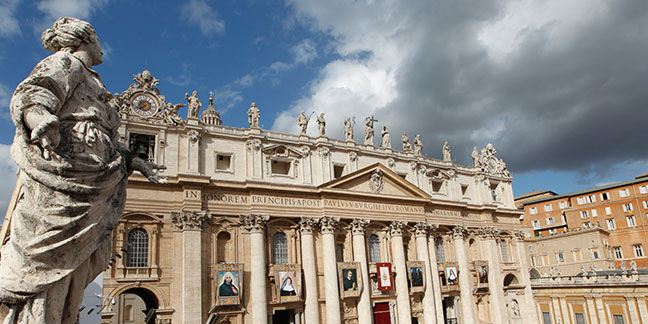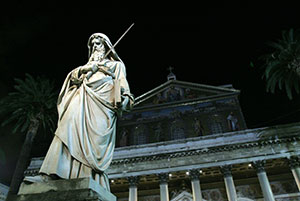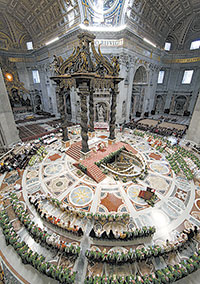 This feast celebrates the dedications of two of the four major basilicas of Rome, named for Sts. Peter and Paul, the Vatican’s patron saints and symbols of the Church’s unity and its universality.
This feast celebrates the dedications of two of the four major basilicas of Rome, named for Sts. Peter and Paul, the Vatican’s patron saints and symbols of the Church’s unity and its universality.
St. Peter’s Basilica was originally built in 323 by the emperor Constantine. The basilica was constructed over the tomb of Peter the Apostle, the first pope.
After standing for more than 1,000 years, Pope Julius II ordered the building to be torn down due to structural concerns. The construction of the new church spanned more than 200 years before its completion. It was dedicated on Nov. 18, 1626.
It is considered the most famous church in Christendom.
St. Paul’s Basilica is located outside the original walls of Rome. It was also originally built by the emperor Constantine, though it was destroyed by fire in 1823.
Donations from around the world made the reconstruction possible. Before the completion of St. Peter’s Basilica, St Paul’s was the largest church in Rome. The basilica was built over St. Paul’s grave, and Pope Pius IX consecrated it in 1854.
These two churches continue to draw millions of faithful pilgrims each year, as well as many visitors from other faiths.
— Catholic News Agency
What is a basilica? There are four “major” or papal basilicas – all of which are in Rome. All other basilicas are called “minor” basilicas.
There are four “major” or papal basilicas – all of which are in Rome. All other basilicas are called “minor” basilicas.
The Diocese of Charlotte has two minor basilicas: Mary, Help of Christians Abbey (better known as Belmont Abbey), and St. Lawrence Basilica in Asheville.
The Asheville basilica states on its website:
The term dates back to the early Greek and Roman times and referred to a type of public building. In the 4th century, basilicas began to be used as places of worship. It was during this time that construction of the greatest basilicas of Rome was started.
Today, the term basilica is a special designation given by the pope to certain churches because of their antiquity, dignity, historical importance or significance as a place of worship.
To become a basilica, the church must have been consecrated. The liturgical rites (celebration of the Holy Eucharist, sacraments of penance and other sacraments) should also be executed in an exemplary way with fidelity to liturgical norms and the active participation of the people of God.
It should also have special significance in the diocese. St. Lawrence, with its unique dome, is the only church designed and built by the renowned Rafael Guastavino.
Because of the relationship between a basilica and the pope, basilicas have the responsibility to promote the study of the documents of the pope and the Holy See, especially those concerning the Sacred Liturgy.
Also, certain days in the liturgical year are to be celebrated with added solemnity, among them the Feast of the Chair of St. Peter (Feb. 22), the Solemnity of Sts. Peter and Paul (June 29), and the anniversary of the election or coronation of the supreme pontiff.
An outward sign and privilege that comes to a basilica is the honor and opportunity to display the seal of the papacy.
Virtual tours online At www.vatican.va: Check out virtual 360-degree tours of St. Peter’s Basilica and St. John Lateran, along with other basilicas and chapels of the Vatican. Click on “Basilicas and Papal Chapels” on the bottom right of the page.
At www.vatican.va: Check out virtual 360-degree tours of St. Peter’s Basilica and St. John Lateran, along with other basilicas and chapels of the Vatican. Click on “Basilicas and Papal Chapels” on the bottom right of the page.


